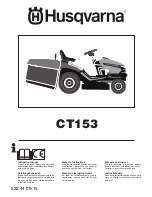
32
s
ectiOn
6— M
aintenance
& a
djustMents
Using the Transmission Bypass Valves
If for any reason the tractor will not drive or you wish to move
the tractor, the two hydrostatic transmissions are equipped with
a bypass valve that will allow you to manually move the tractor
short distances.
WARNING!
Do not tow the tractor, even with the
bypass rod engaged. Serious transmission damage
will result from doing so.
From just in front of the engine and just behind the seat,
1.
locate the transmission bypass valves. Refer to Fig. 6-6.
Using a standard
2.
7⁄16
” wrench turn the valve counter-
clockwise one quarter turn.
Repeat the above procedure to engage the other bypass
3.
valve on the other side of the tractor.
After moving the tractor, return both valves to the
4.
operating position by turning the valve clockwise, but do
not overtighten.
NOTE:
The tractor will not drive with the bypass valves in the
engage position.
Figure 6-6
Battery Storage
When storing the tractor for extended periods, disconnect
1.
the negative battery cable. It is not necessary to remove the
battery.
All batteries discharge during storage. Keep the exterior
2.
of the battery clean, especially the top. A dirty battery will
discharge more rapidly.
The battery must be stored with a full charge. A discharged
3.
battery can freeze sooner than a charged battery. A fully
charged battery will store longer in cold temperatures than
hot. Refer to chart below.
Specific Gravity
Freezing Temp (°F)
1.265
-71
1.250
-62
1.200
-16
1.150
5
1.100
16
Recharge battery when ever the specific gravity value is
4.
less than 1.225.
Tractor Storage
If your tractor is not going to be operated for an extended period
of time (thirty days to approximately six months), the tractor
should be prepared for storage. Store the tractor in a dry and
protected location. If stored outside, cover the tractor (including
the tires) to protect it from the elements. The procedures
outlined below should be performed whenever the tractor is
placed in storage.
Change the engine oil and filter following the instructions
1.
provided in the engine manual packed with this manual.
WARNING!
never store the tractor with LPG tank
indoors or in poorly ventilated enclosures, where
fuel fumes may reach an open flame, spark or pilot
light as on a furnace, water heater, clothes dryer, etc.
If storing the tractor for 30 days or more:
2.
The LPG tank must be removed and safely stored.
a.
Emptying the fuel system:
b.
Prior to putting the tractor in storage, monitor
•
fuel consumption with the goal of running
the LPG tank empty.
Close the fuel valve and disconnect the hose
•
from the LPG tank.
Start the engine and allow it to run out of fuel.
•
This will prevent gum and varnish deposits
from forming. Replace the fuel filter.
Remove the spark plugs and pour approximately one
3.
ounce of oil into each cylinder. Crank the engine one or
two turns to spread the oil evenly on the cylinder walls.
Replace the spark plugs.
Summary of Contents for THE TANK S6031
Page 45: ...Notes 12 45 ...
















































